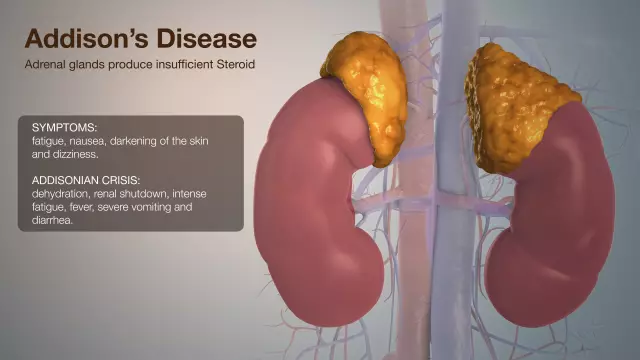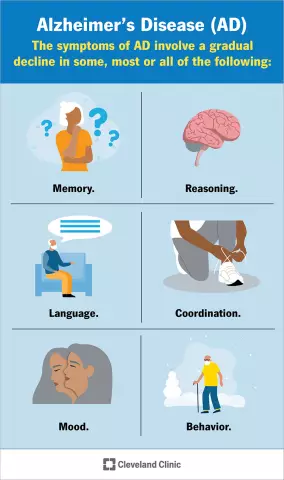- Author Rachel Wainwright [email protected].
- Public 2024-01-15 19:51.
- Last modified 2025-11-02 20:14.
Monocytosis
The content of the article:
- Causes of monocytosis
- Forms
- Signs
- Features of the course in children
- Diagnostics
- Treatment
- Prevention
- Consequences and complications
- Video
Monocytosis is a higher than normal content of monocytes in the blood.
Monocytes are a type of mononuclear leukocytes, white blood cells that belong to the immune system, that is, they perform a protective function in the body. These are the largest of the white blood cells. Formed in the bone marrow, from where they enter the blood. They circulate in the blood from 36 to 104 hours, after which they go beyond the vessels into the tissue, where they mature and become macrophages. Their feature is the ability to phagocytosis, ie, the absorption of foreign particles (viruses, bacteria) and the body's own "debris" (for example, dead leukocytes, necrotic tissues). Monocytes can move towards the site of inflammation through a mechanism called chemotaxis. Once in the inflammatory focus, these cells remain active in an acidic environment typical of inflammation, where each monocyte is able to absorb up to 100 microbial agents. Cleansing the inflammatory focus, monocytes play the role of a kind of wipers.

Monocytes perform the function of "wipers" in the body, cleaning the inflammatory focus from foreign particles
Normally, monocytes make up from 1 to 10-11% of all leukocytes, in absolute value, the normal indicator is the range from 0.08 x 10 9 / l to 0.8 x 10 9 / l. When the content is> 0.8 x 10 9 / l, one speaks of monocytosis.
Causes of monocytosis
Physiologically, monocytes are slightly increased (compared to the norm in adults) in children under 7 years of age, especially in children of the first year of life. In addition, an excess of their indicators in women in the luteal phase of the menstrual cycle may be observed, since during this period the functional layer of the endometrium is rejected, which is accompanied by some signs of an inflammatory reaction, which is perceived by the immune system as inflammation, although it is not.
A short-term increase in the level of monocytes can be a reaction to stress, a longer transient monocytosis can be observed during the period of convalescence after an acute infectious disease or surgery. It can also be caused by foreign matter (not infection) entering the respiratory tract.
The reasons for the increase in the number of monocytes:
| Group of diseases | Examples of |
| Infections | Viral (for example, infectious mononucleosis, eosinophilic monocytosis, herpes), bacterial (subacute septic endocarditis of streptococcal or staphylococcal nature), rickettsion (typhoid fever), fungal, protozoal (malaria, leishmaniasis) diseases. |
| Granulomatosis (infectious and non-infectious diseases characterized by the development of granulomas) | Tuberculosis, especially in active form, brucellosis, syphilis, sarcoidosis, enteritis, ulcerative colitis. |
| Collagenoses (diffuse connective tissue diseases) | Scleroderma, systemic lupus erythematosus, rheumatoid arthritis, periarteritis nodosa. |
| Diseases of the hematopoietic system | Acute myeloid leukemia, acute monoblastic leukemia, Hodgkin's lymphoma, chronic myelomonocytic leukemia, monocytic leukemia, myeloid leukemia. |
| Endocrine diseases, metabolic disorders | Itsenko-Cushing's syndrome, atherosclerosis. |
Forms
As mentioned above, an increase in the number of monocytes in the blood is physiological and pathological, temporary and permanent. In addition, monocytosis occurs:
- relative - when the percentage of monocytes increases relative to other leukocytes;
- absolute - when there is an absolute increase in the number of monocytes.
Absolute monocytosis accompanies the immune response to bacterial infection; at the height of the disease, a short period of relative monocytosis is usually observed.
Infections caused by intracellular pathogens, for example, viruses and fungi, on the contrary, are characterized by prolonged relative monocytosis, accompanied by lymphocytosis.
If, after clinical recovery, even a slightly increased level of monocytes continues to be determined in the blood, this is evidence of incomplete recovery, the transition of the infection to a chronic form.
Signs
Monocytosis does not have any characteristic external manifestations and is determined in the laboratory by examining a blood sample. Symptoms correspond to the clinical picture of the disease or condition that caused the relative or absolute increase in the level of monocytes.
Features of the course in children
In general, monocytosis in children has the same causes and laboratory signs as in adults, however, before talking about an increased content of monocytes in the blood of a child, age norms must be taken into account:
| Age | Range, 10 9 / l | The number of monocytes,% |
| First days | 0.05-1.1 | 4-12 |
| 3-14 days | 0.05-0.7 | 5-15 |
| From 14 days to 1 year | 0.05-0.8 | 4-10 |
| 1 to 10 years old | 0.05-0.8 | 3-10 |
| 10 years and older | 0.05-0.8 | 1-10 |
If monocytosis in a child persists for a long time, it is necessary to conduct an examination, first of all, in order to exclude malignant blood diseases and systemic diseases.
Diagnostics
The main method for diagnosing monocytosis is a clinical (general) blood test. Since monocytes are one of the forms of leukocytes, their number is determined when calculating the leukocyte formula. International designation of leukocytes - WBC (white blood cells, white blood cells), monocytes in the leukocyte formula are designated as MON (monocytes).
Monocytosis is diagnosed when the content of monocytes in the blood exceeds 1-11% or 0.8 x 10 9 / l.
After detecting an increased number of monocytes in the blood, a diagnostic search is conducted in the direction of the cause of this condition. Previous infectious diseases should be considered, as well as any existing symptoms. If necessary, a detailed examination is carried out, including additional blood tests, imaging techniques (for example, magnetic resonance imaging or computed tomography of the lymph nodes), bone marrow puncture, lymph node biopsy, etc.

To diagnose monocytosis, a clinical blood test is performed
Monocytosis in some diseases can serve as a prognostic sign. Thus, it is known that a significant increase in the number of intermediate monocytes in atherosclerosis increases the risk of cardiovascular events.
An unmotivated persistent increase in the number of monocytes can be a harbinger of acute leukemia, which occurs several years later. The reason for this phenomenon has not yet been established.
Treatment
Treatment for monocytosis depends on what caused it. In some cases (the period of recovery after an infectious disease or surgery, physiological monocytosis in women or children), nothing needs to be treated, however, it may be necessary to repeat a clinical blood test in order to exclude a possible erroneous interpretation of monocytosis as physiological. For example, a woman may be assigned a second blood test 1-2 weeks after the first, so that it falls on another phase of the menstrual cycle.
If, after an infectious disease, a persistent increase in the level of monocytes is noted, this is an indicator of the chronicity of the infection, which means that an additional course of anti-infectious therapy may become necessary.
Treatment of systemic diseases (collagenosis, vasculitis) depends on the specific diagnosis, usually it consists in a course of glucocorticoids, aminoquinoline derivatives, etc. The therapy of these diseases is usually lifelong - supporting during periods of remission and active during periods of exacerbations.
If monocytosis is caused by an oncological pathology, namely, a malignant lesion of the blood, treatment consists of chemotherapy, i.e., several courses of systemic drugs of cytostatic action, sometimes in combination with radiation therapy.
After completion of treatment, a control blood test is performed to confirm the normalization of the number of monocytes in the blood.
Prevention
Prevention of monocytosis is to prevent those diseases that caused it. The risk of developing infectious diseases that cause an increase in the number of monocytes can be reduced if measures are taken to reduce the likelihood of contact with an infection on the one hand, and to increase the body's resistance on the other. This requires:
- Follow the hygiene rules carefully.
- Minimize visits to public places during seasonal and other epidemics.
- Maintain optimal sanitary and microclimatic conditions in the home.
- Adhere to a healthy lifestyle. This concept includes a reasonable mode of work and rest, regular moderate physical activity and proper nutrition.
- Seek medical attention promptly in case of symptoms of any disease.
- Completely undergo a course of treatment for existing diseases, strictly adhering to medical prescriptions in order to avoid the transition of diseases to a chronic form, which is more difficult to treat.
Consequences and complications
Being not an independent disease, but only a symptom reflecting the presence of pathology in the body, monocytosis in itself does not lead to any consequences, however, the diseases that accompany it can have them, and they are quite serious, up to a lethal outcome (depending on the specific pathology). In case of recovery, the number of monocytes returns to normal.
Video
We offer for viewing a video on the topic of the article.

Anna Kozlova Medical journalist About the author
Education: Rostov State Medical University, specialty "General Medicine".
The information is generalized and provided for informational purposes only. At the first sign of illness, see your doctor. Self-medication is hazardous to health!






